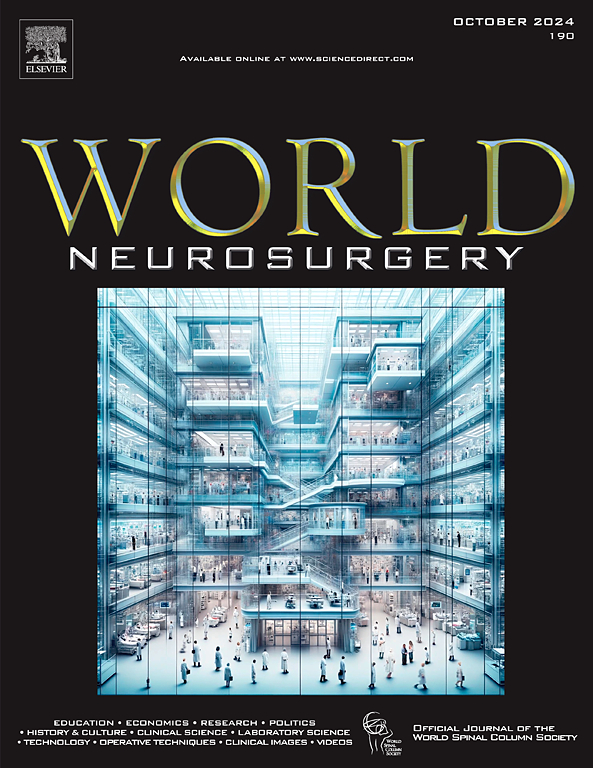儿童和青少年恶性周围神经鞘肿瘤(MPNST):一项基于人群的研究。
IF 1.9
4区 医学
Q3 CLINICAL NEUROLOGY
引用次数: 0
摘要
目的:本研究旨在利用监测、流行病学和最终结果(SEER)数据库分析儿童恶性周围神经鞘瘤(MPNST)的预后,以确定影响生存的重要预后因素:利用 SEER 数据库进行了一项回顾性队列分析,确定了 2000 年至 2019 年期间诊断为 MPNST 的儿童患者。提取并分析了人口统计学数据、肿瘤特征、治疗方式和生存结果。主要结果指标是总生存期(OS),采用卡普兰-梅耶法和考克斯比例危险模型进行分析,以评估临床和人口学因素对生存期的影响。此外,我们还构建了一个预测儿科多发性骨髓瘤患者OS的提名图:研究共纳入208例MPNST儿科患者,性别分布接近均等,白人占大多数。MPNST最常见的部位是躯干和核心区域(38.9%)以及四肢(34.1%)。大多数患者(87.0%)接受了手术治疗,44.7%的患者接受了放射治疗。整个组群的总体5年生存率为59.9%。与不进行手术治疗相比,手术治疗的生存率更高。根据考克斯比例危险回归的结果,在该模型中,只有SEER分期是OS的重要独立预测因素:结论:小儿多发性骨髓瘤的预后具有挑战性,诊断时的SEER分期对其影响很大。手术作为 MPNST 的一线治疗方法至关重要,尤其是在肿瘤确诊为局部肿瘤的情况下。本文章由计算机程序翻译,如有差异,请以英文原文为准。
Malignant Peripheral Nerve Sheath Tumors in Children and Adolescents: A Population-Based Study
Objective
This study aims to analyze the prognosis of malignant peripheral nerve sheath tumors (MPNSTs) in children using the Surveillance, Epidemiology, and End Results (SEER) database to identify significant prognostic factors affecting survival.
Methods
A retrospective cohort analysis was conducted using the SEER database, identifying pediatric patients diagnosed with MPNSTs from 2000 to 2019. Demographic data, tumor characteristics, treatment modalities, and survival outcomes were extracted and analyzed. The main outcome measure was overall survival (OS), analyzed using Kaplan-Meier methods and Cox proportional hazards models to assess the impact of clinical and demographic factors on survival. Furthermore, we constructed a nomogram to predict OS in pediatric MPNSTs patients.
Results
The study included 208 pediatric patients with MPNSTs, with a near-equal distribution across gender and a majority being white. The most common sites for MPNSTs were the trunk and core areas (38.9%) and the limbs (34.1%). A majority of the patients (87.0%) underwent surgical treatment, and radiation therapy was administered to 44.7% of the patients. The overall 5-year survival rate for the entire cohort was 59.9%. When compared to no surgery, surgery had better survival outcomes. According to the results of Cox proportional hazard regression, only the SEER stage was an important independent predictor of OS in this model.
Conclusions
Pediatric MPNSTs presents with a challenging prognosis, significantly influenced by the SEER stage at diagnosis. Surgery is crucial as first-line treatment for MPNSTs, especially if the tumor is localized at diagnosis.
求助全文
通过发布文献求助,成功后即可免费获取论文全文。
去求助
来源期刊

World neurosurgery
CLINICAL NEUROLOGY-SURGERY
CiteScore
3.90
自引率
15.00%
发文量
1765
审稿时长
47 days
期刊介绍:
World Neurosurgery has an open access mirror journal World Neurosurgery: X, sharing the same aims and scope, editorial team, submission system and rigorous peer review.
The journal''s mission is to:
-To provide a first-class international forum and a 2-way conduit for dialogue that is relevant to neurosurgeons and providers who care for neurosurgery patients. The categories of the exchanged information include clinical and basic science, as well as global information that provide social, political, educational, economic, cultural or societal insights and knowledge that are of significance and relevance to worldwide neurosurgery patient care.
-To act as a primary intellectual catalyst for the stimulation of creativity, the creation of new knowledge, and the enhancement of quality neurosurgical care worldwide.
-To provide a forum for communication that enriches the lives of all neurosurgeons and their colleagues; and, in so doing, enriches the lives of their patients.
Topics to be addressed in World Neurosurgery include: EDUCATION, ECONOMICS, RESEARCH, POLITICS, HISTORY, CULTURE, CLINICAL SCIENCE, LABORATORY SCIENCE, TECHNOLOGY, OPERATIVE TECHNIQUES, CLINICAL IMAGES, VIDEOS
 求助内容:
求助内容: 应助结果提醒方式:
应助结果提醒方式:


